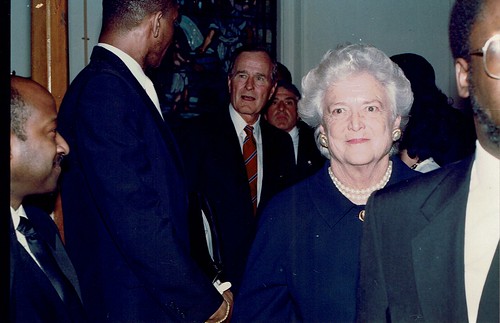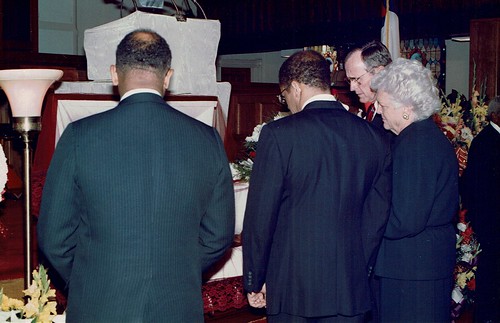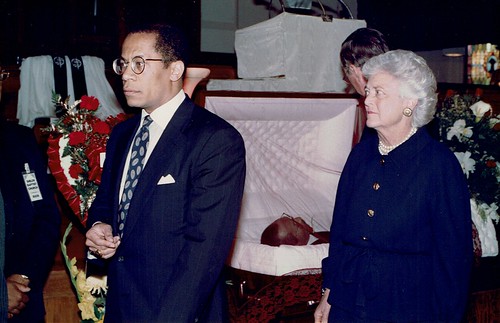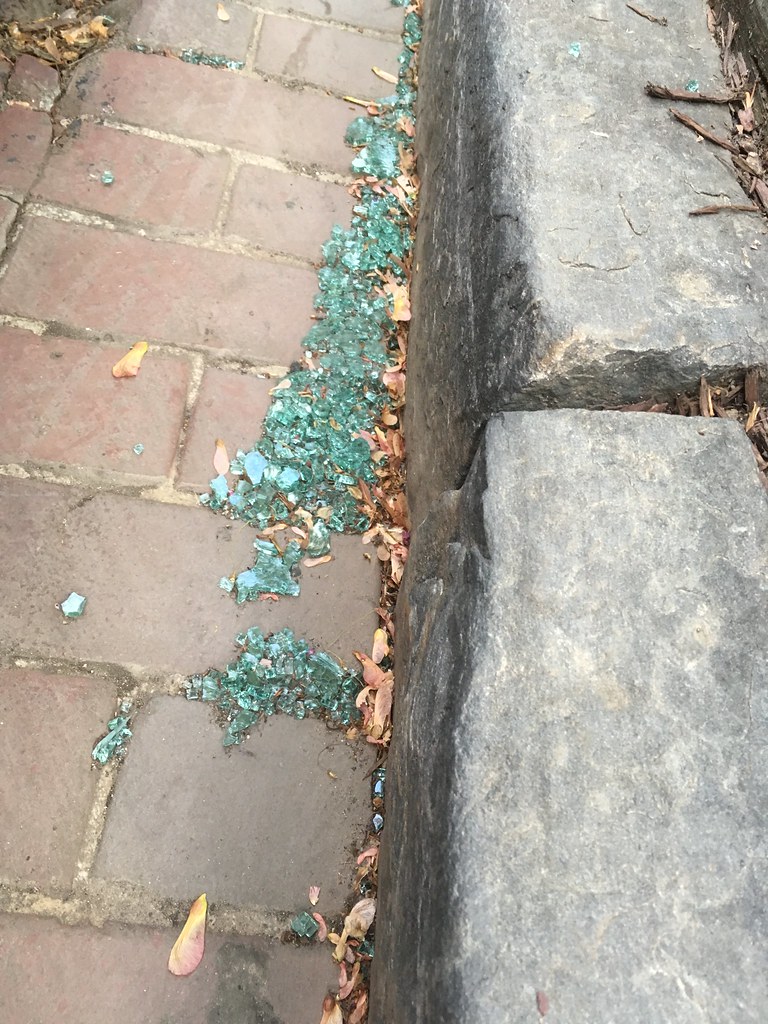 Don’t leave stuff in your car, lest you be rewarded with street diamonds. Glistening blue or black diamonds that shine in the sun on the sidewalk and on the street. The thief who steals the $2.00 charging cord and the $1.85 from the console does not think about the hundreds you shell out to replace the window they broke. Worse is when you do keep everything out of sight but somehow they knew you had something worth taking hidden. Or when the chemically altered brain mistakenly thinks he can sell that radio he pulled from your car, later to find out he wasted his time, and your peace.
Don’t leave stuff in your car, lest you be rewarded with street diamonds. Glistening blue or black diamonds that shine in the sun on the sidewalk and on the street. The thief who steals the $2.00 charging cord and the $1.85 from the console does not think about the hundreds you shell out to replace the window they broke. Worse is when you do keep everything out of sight but somehow they knew you had something worth taking hidden. Or when the chemically altered brain mistakenly thinks he can sell that radio he pulled from your car, later to find out he wasted his time, and your peace.
Month: April 2018
Character of a neighborhood: People not buildings
Recently a co-worker of mine retired. At his retirement party a few other retirees I knew showed up and I remembered what the place was like when they still worked there, and how the place will change when my co-worker becomes another retiree. The building where we work has, for the most part, despite several renovations since it was built in the early 20th Century, remained unchanged. But the workplace keeps changing, with each new person, with each retirement, departure, and in some cases, death.
The neighborhood is the same way. The spirit of my block changed with the crowd who showed up in the 00s and eventually departed in the early teens. The buildings has relatively remained unchanged. There has been some infill here, a pop up or pop back there, but for the most part the buildings have not changed much over the years. But the block has changed, and will continue to do so long after I’ve moved on*.
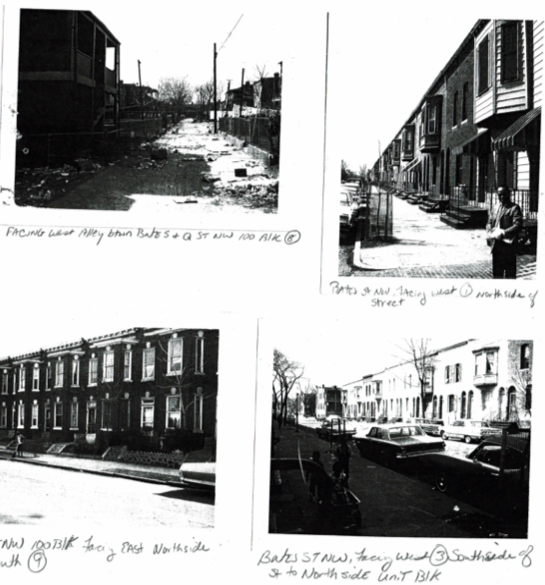 If there was to be another possible historic landmarking or whatever in Truxton Circle I would predict it would happen with the Bates Street houses. I’d hope not, but there is a history there, and with a few exceptions the overall style on the unit to the 200 blocks of Bates have been unchanged.
If there was to be another possible historic landmarking or whatever in Truxton Circle I would predict it would happen with the Bates Street houses. I’d hope not, but there is a history there, and with a few exceptions the overall style on the unit to the 200 blocks of Bates have been unchanged.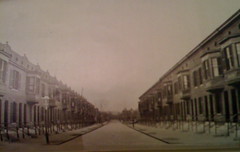
However the character of Bates Street has changed, and continues to change. It’s not the same street when the developer, the Washington Sanitary Improvement Company built them in the 1900s. It was purposefully segregated and all rentals. By the 1940s it there were a few Black households on Bates, and one of the few places with Whites in Truxton Circle. By the 1960s the blocks were o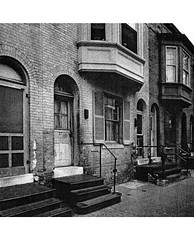 n the government’s radar for urban renewal because it was run down. Most of the families (according to a report about Bates of the time) could only afford public housing, if they were to be relocated. However the urban renewal and the large scale demolition of neighborhoods was challenged. Instead the some of the Bates St buildings were rehabilitated, but the neighborhood was still struggling. When I showed up in the early 21st Century there were many Section 8 houses, or houses that neighbors strongly suspected were Section 8, because the families’ crises kept playing out on the streets. A lot of those people are gone, but the buildings, for the most part, remain the same, all without the Historic Preservation Review Board.
n the government’s radar for urban renewal because it was run down. Most of the families (according to a report about Bates of the time) could only afford public housing, if they were to be relocated. However the urban renewal and the large scale demolition of neighborhoods was challenged. Instead the some of the Bates St buildings were rehabilitated, but the neighborhood was still struggling. When I showed up in the early 21st Century there were many Section 8 houses, or houses that neighbors strongly suspected were Section 8, because the families’ crises kept playing out on the streets. A lot of those people are gone, but the buildings, for the most part, remain the same, all without the Historic Preservation Review Board.
Being a person who participates in communal worship, I have heard on more than one occasion, a church is the congregation/ people, not the building. Likewise, the character of the neighborhood is the people, not the buildings. Bates Street has been a White enclave, a poor Black street and now a mixed income, mixed race neighborhood. In twenty years, it might be something else, and no building preservation will prevent it.
*There is no way I’m retiring here. The stairs in my house are murder on my knees.
Barbara Bush in Shaw
So when I heard that the former First Lady Barbara Bush had died a couple of days ago, I thought. I have some photos of her, in Shaw.
I have a big stack of photos my aunt took in either 1991 or 1992 (I’ve been too lazy to bother to get the dates) of a funeral. The deceased then was Rev. Henry C. Gregory III, who I gather was the pastor for Shiloh Baptist Church at 9th and P Streets in Shaw. Rev. Gregory was apparently important enough to get the then President, the Mayor, and some other important looking people I cannot identify to come to his funeral. It doesn’t help that the photographer didn’t care to go through the photos to identify people. So below are the pictures. If you can tell me who is in them, beyond the dead guy and the Bushes, that would be helpful.
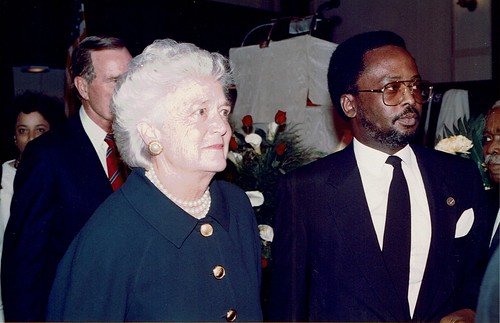
Victims of the 1968 Riots- 1718 14th St NW- Chinese Laundry
So when I was doing the Truxton Circle neighborhood history and using the census to track every resident (see TruxtonCircle.org ) I noticed almost every Chinese person, usually guys, who identified as Chinese (so not that one Chinese guy who was white) were listed as being in the laundry business. Almost everyone. I am hoping Chinese residents in the 1950 census do something else besides cleaning clothes.
Anyway. So it was no big surprise to find a Chinese launderer who was a victim of the 1968 riots. Shaw Foo Chin was the owner of Bill’s Laundry and Dry Cleaning at 1718 14th Street NW in Logan Circle or U Street and experienced damage and theft on April 5th and 6th. It was a small business employing just himself and his wife. He owned the building as well.
He experienced extensive damage and theft. He lost a sign, had broken glasss and people stole his customers clothes. About half of his business came from the immediate neighborhood, so it may be a fair guess that rioters were not only taking from Mr. Chin, they were also taking from their neighbors.
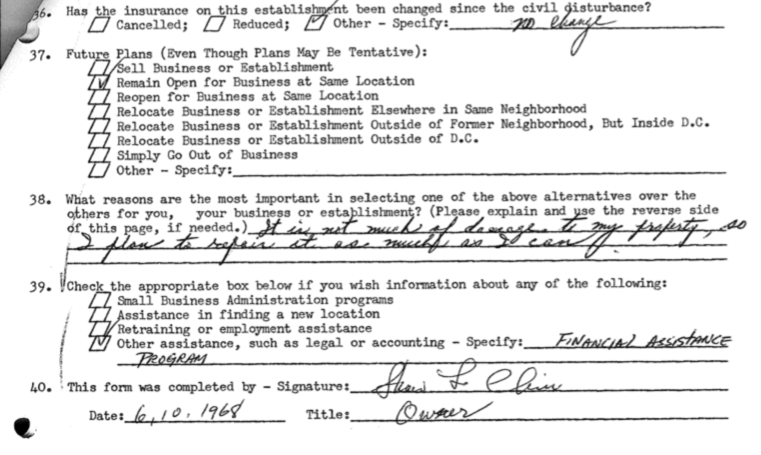 Mr. Chin seems fairly resilient, like the past few businessmen I’ve reviewed here. His insurance didn’t change, his business was still open in June, and he wrote: It is not much damage to my property, so I plan to repair it as much as I can. He did however request financial assistance.
Mr. Chin seems fairly resilient, like the past few businessmen I’ve reviewed here. His insurance didn’t change, his business was still open in June, and he wrote: It is not much damage to my property, so I plan to repair it as much as I can. He did however request financial assistance.
Probably nothing new at the corner of Florida & 3rd NW
So mommy (me) decided she wanted some vermouth and pintxos and so we (me and the baby) sat out on the patio of ANXO. While I was there I noticed the owner of the commercial property across the street and another man talking in front. The other man had a clipboard. It’s probably nothing.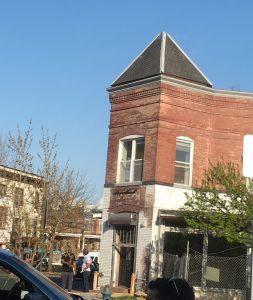
I did see a mention a while back on PoPville about this, but we’ve been on this ride before and it goes nowhere. Many, many years back, way before ANXO, two ladies wanted to turn the building into a wine bar. However, according to them, the landlord was difficult. It has been vacant for years, but well kept.
I also noticed a kitty in the upstairs window. Kitty in the window means the upstairs is occupied. At least occupied by a black and white kitty cat, so I need to take it off my vacant list on my other blog.
Really, probably nothing will change. If it does, I’ll be pleasantly (hopefully) surprised.
A better argument would have been for the suburbs to step up
So the Post has another feel bad about gentrification opinion piece that appeared in Sunday’s print version but has been on-line for several days. Reading “Poverty is Moving to the Suburbs but the On Poverty Didn’t“, I almost think the author is trying to argue that poor suburbanites should use DC resources.
No. No. No. No. No. No. No. No. No. No. No. No. No. No. No. No. No. No. No. No. No. No. No. No.
My ire burns and seethes every time I see a car with Maryland tags drop off a kid in front of a DC charter school. If Maryland parents like DC charters so damned much they should fight for tons of them in Maryland. It’s not just schools, it’s other services that DC taxpayers support and Maryland citizens, who have the privilege of a vote in both houses of Congress, something DC voters lack. It does not help that many DC government workers live in the suburbs, it may have them forgetting about boundaries. In some cases, boundaries don’t or can’t matter, like foster care* and libraries**. I’m not against co-operation between the Districts and the burbs, but like WMATA, the costs need to be shared.
Or/and suburban areas need to step up. Where they can’t do it themselves, they need to partner with the District or other suburban where it makes sense. But Maryland or Virginia residents using DC agencies as if they were DC residents is wrong. The suburbs have something to offer DC, there are welding classes out there, but not here. We can all help each other out, but each government needs to be accountable to and responsible for their own citizens.
*There are many DC kids with Maryland foster families.
**Some systems allow for people who work in the area to apply for cards and privileges.
Victims of the 1968 riots-1618 7th Street NW- hopeful with can do spirit
The building that is 1618 7th St NW is so nondescript it just blends into the non-cool side of the 1600 block of 7th. Now the cool end is where the Dacha beer garden sits. 1618 has a rolltop gate that I’ve never seen unrolled. It seems shuttered or not open to me.
Anyway, Carl R. Webb was the manager and owner of Personality Studio and Gift Shop at 1618 7th Street NW, near the corner of 7th and Rhode Island Avenue. Mr. Webb was a Black man over the age of 50 who owned the building and the business that had been there prior to the 1940s. He ran it with a family member, possibly his wife.
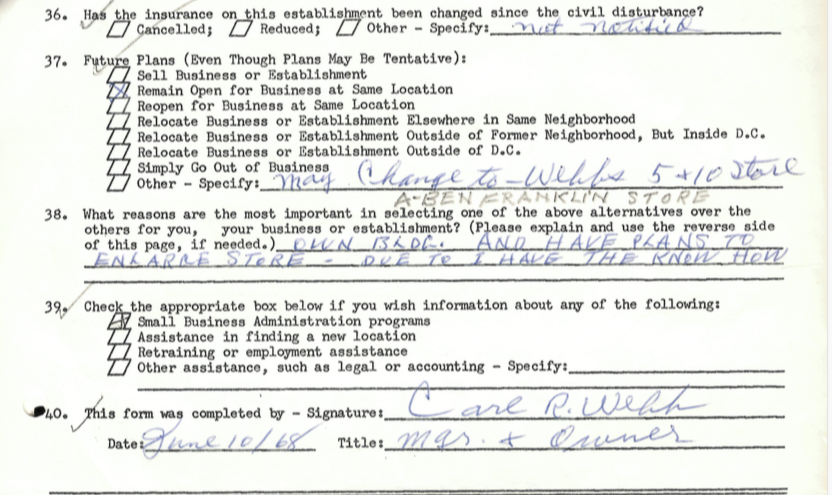 Despite experiencing extensive glass breakage and theft of merchandise over two days, Mr. Webb seems pretty positive about going forward. He didn’t seem to lose insurance, some like other owners. He did ponder changing the name and enlarging the store. He claimed he could enlarge it because he has “the know how.” I don’t know if he ever did, I’d have to look that up in the 1970 directory. Considering his age, I’m a tiny bit doubtful, but I do applaud his attitude regarding the whole thing.
Despite experiencing extensive glass breakage and theft of merchandise over two days, Mr. Webb seems pretty positive about going forward. He didn’t seem to lose insurance, some like other owners. He did ponder changing the name and enlarging the store. He claimed he could enlarge it because he has “the know how.” I don’t know if he ever did, I’d have to look that up in the 1970 directory. Considering his age, I’m a tiny bit doubtful, but I do applaud his attitude regarding the whole thing.
Victims of the 1968 riots: 703 R St NW or it wasn’t that bad
So there isn’t anything at 703 R St NW now. You plug it into Google maps and you get the intersection of R and 7th Streets NW. I’m guessing that 703 is over where the CaBi bikeshare sits. Before that it was a parking lot.
Apparently, Ellis Transfer, a moving company owned by Henry Ellis was the business at 703 R St NW prior to the riots. Mr. Ellis was a local African American man who lived around the corner on the 1600 block of 6th St NW. His post-riot conclusion could be summed up as ‘not that bad’. 
Well what he actually wrote was: “Business as I have done pretty good here, but business is slow now and I have had to go to work elsewhere, my wife is keeping things going here.” Including himself and his wife he went from 8 employees to six due to business slowing down. The damage he experienced was extensive glass breakage and some minor fire damage on the roof. Unlike say a retail store, a moving business isn’t that dependent on foot traffic, so I won’t say the riot had a major impact on his business. But the building isn’t there, so something happened between 1968 and whenever the Shaw metro station got put in.
Mr. Ellis had no plans of shutting down his business or relocating. Was he a victim of the riots? Yes, as broken glass and a slightly damaged roof is unpleasant. But he was resilient and his business was the kind that could weather that kind of storm.
Victims of the Riot: Jessie McCain 643 P St NW
It has been 50 years since the riots that destroyed several DC commercial corridors. And it has taken about 50 years for life and vibrancy to return to those corridors. However at the time, several of those places were already in a downward spiral. The heyday had passed. When the community is strong and disaster strikes, you rebuild. When it is weak, you leave.
 Jessie McCain had a barbershop at 643 P St NW. During the riots it was completely destroyed. So what is there now? A parking lot. Next to it is a vacant lot, where Clark Construction has a couple of mobile office trailers that have been there for years. So in 50 years the only improvement has been clearing off the rubble.
Jessie McCain had a barbershop at 643 P St NW. During the riots it was completely destroyed. So what is there now? A parking lot. Next to it is a vacant lot, where Clark Construction has a couple of mobile office trailers that have been there for years. So in 50 years the only improvement has been clearing off the rubble.
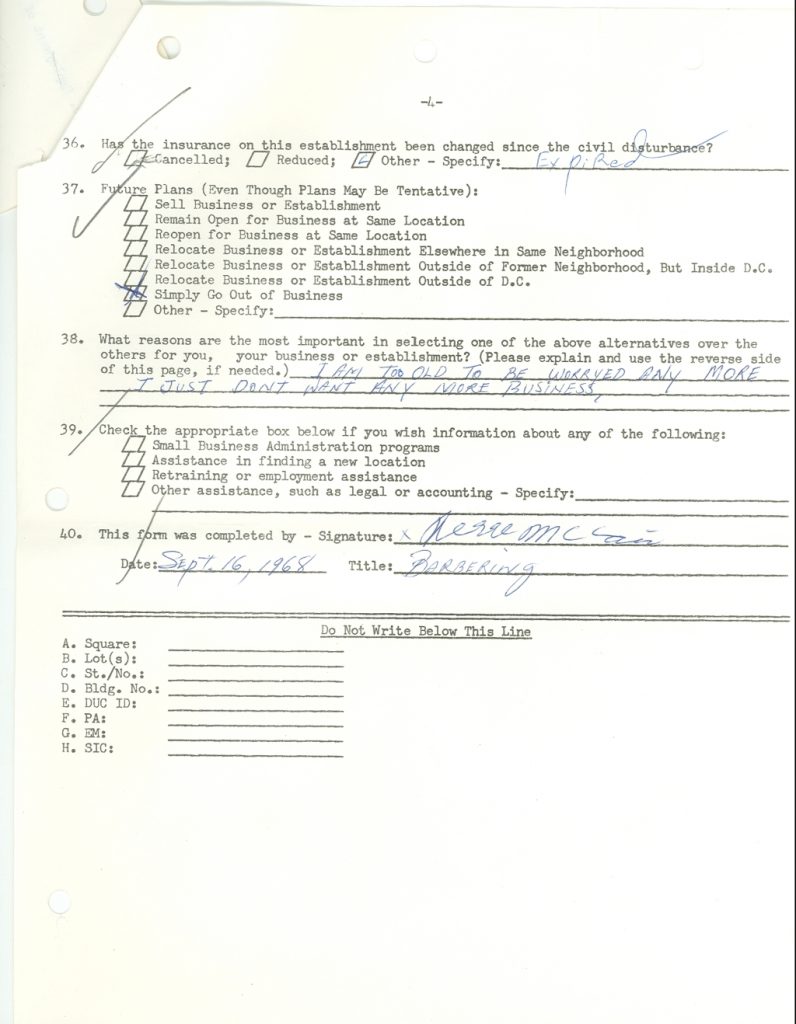 Just after the riots officials sent out surveys to business owners to figure out the level of damage. The image above is from the survey Mr. McCain returned in September 1968. He was a 50 year old African American, and back in the 60s, 50 was old. Fifty year olds are a whole lot healthier and active these days, but back then they were well over the hill, probably not going to see 65. The destruction the riot brought Mr. McCain was the final straw. He wrote: “I am too old to be worryed [sic] any more. I just don’t want any more business.”
Just after the riots officials sent out surveys to business owners to figure out the level of damage. The image above is from the survey Mr. McCain returned in September 1968. He was a 50 year old African American, and back in the 60s, 50 was old. Fifty year olds are a whole lot healthier and active these days, but back then they were well over the hill, probably not going to see 65. The destruction the riot brought Mr. McCain was the final straw. He wrote: “I am too old to be worryed [sic] any more. I just don’t want any more business.”
There were plenty more victims in Shaw for whom the riots were the final straw, and I’ll introduce you to them in the month of April.

